Cystic Fibrosis: SOAP Note, Nursing Care Plan, and Patient Education
VerifiedAdded on 2023/04/25
|10
|2449
|201
Homework Assignment
AI Summary
This assignment presents a comprehensive SOAP note and nursing care plan for a 13-year-old patient, JR, diagnosed with cystic fibrosis. The SOAP note details subjective data (patient reports, family history), objective data (vital signs, physical appearance), assessment (patient's condition, anxiety), and plan (medications, education, nutrition, referrals). The assignment delves into the pathophysiology of cystic fibrosis, caused by a mutation in the CFTR gene, and its impact on the lungs, pancreas, and sweat glands. It outlines three nutritional needs for the patient, including protein-rich, fiber-rich, and antioxidant-rich diets. Three nursing diagnoses (ineffective airway clearance), actions (chest physiotherapy, monitoring secretions), and patient education strategies are discussed, focusing on disease understanding, treatment rationale, and self-management. The conclusion emphasizes the prioritization of medication for airway clearance, addressing nutritional needs, and providing psychotherapy to improve the patient's well-being and facilitate a return to a normal life.
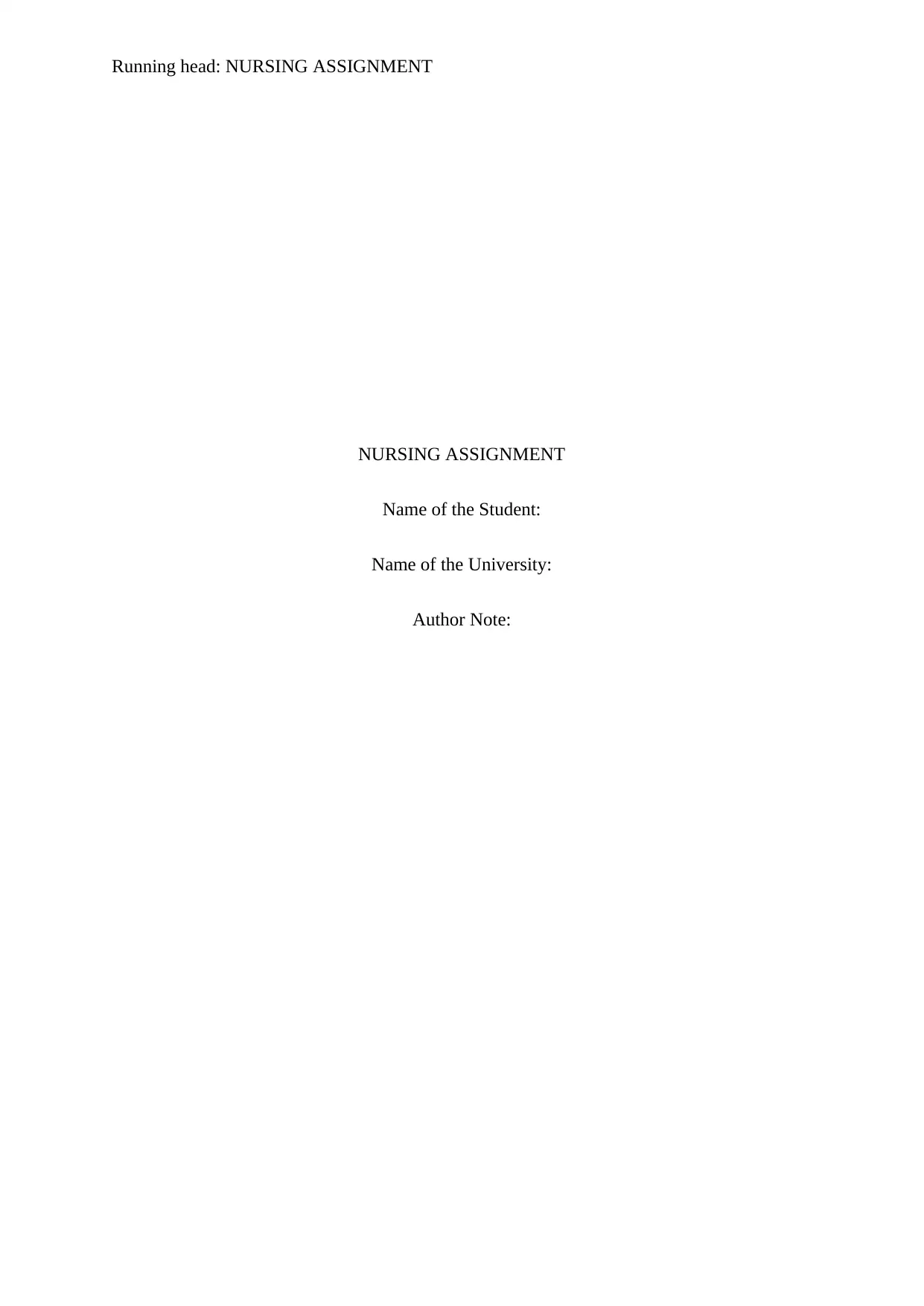
Running head: NURSING ASSIGNMENT
NURSING ASSIGNMENT
Name of the Student:
Name of the University:
Author Note:
NURSING ASSIGNMENT
Name of the Student:
Name of the University:
Author Note:
Secure Best Marks with AI Grader
Need help grading? Try our AI Grader for instant feedback on your assignments.
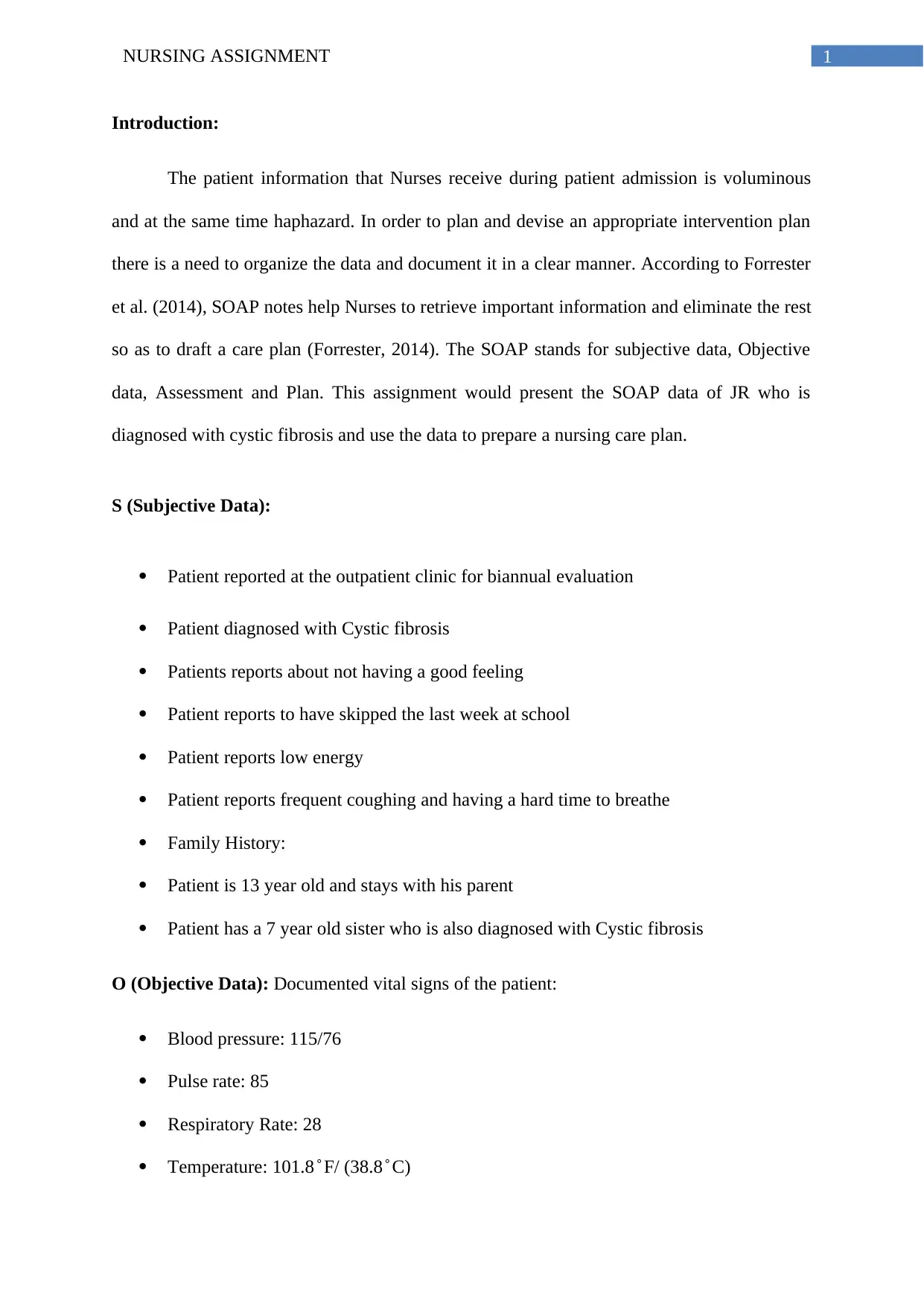
1NURSING ASSIGNMENT
Introduction:
The patient information that Nurses receive during patient admission is voluminous
and at the same time haphazard. In order to plan and devise an appropriate intervention plan
there is a need to organize the data and document it in a clear manner. According to Forrester
et al. (2014), SOAP notes help Nurses to retrieve important information and eliminate the rest
so as to draft a care plan (Forrester, 2014). The SOAP stands for subjective data, Objective
data, Assessment and Plan. This assignment would present the SOAP data of JR who is
diagnosed with cystic fibrosis and use the data to prepare a nursing care plan.
S (Subjective Data):
Patient reported at the outpatient clinic for biannual evaluation
Patient diagnosed with Cystic fibrosis
Patients reports about not having a good feeling
Patient reports to have skipped the last week at school
Patient reports low energy
Patient reports frequent coughing and having a hard time to breathe
Family History:
Patient is 13 year old and stays with his parent
Patient has a 7 year old sister who is also diagnosed with Cystic fibrosis
O (Objective Data): Documented vital signs of the patient:
Blood pressure: 115/76
Pulse rate: 85
Respiratory Rate: 28
Temperature: 101.8 ̊ F/ (38.8 ̊ C)
Introduction:
The patient information that Nurses receive during patient admission is voluminous
and at the same time haphazard. In order to plan and devise an appropriate intervention plan
there is a need to organize the data and document it in a clear manner. According to Forrester
et al. (2014), SOAP notes help Nurses to retrieve important information and eliminate the rest
so as to draft a care plan (Forrester, 2014). The SOAP stands for subjective data, Objective
data, Assessment and Plan. This assignment would present the SOAP data of JR who is
diagnosed with cystic fibrosis and use the data to prepare a nursing care plan.
S (Subjective Data):
Patient reported at the outpatient clinic for biannual evaluation
Patient diagnosed with Cystic fibrosis
Patients reports about not having a good feeling
Patient reports to have skipped the last week at school
Patient reports low energy
Patient reports frequent coughing and having a hard time to breathe
Family History:
Patient is 13 year old and stays with his parent
Patient has a 7 year old sister who is also diagnosed with Cystic fibrosis
O (Objective Data): Documented vital signs of the patient:
Blood pressure: 115/76
Pulse rate: 85
Respiratory Rate: 28
Temperature: 101.8 ̊ F/ (38.8 ̊ C)
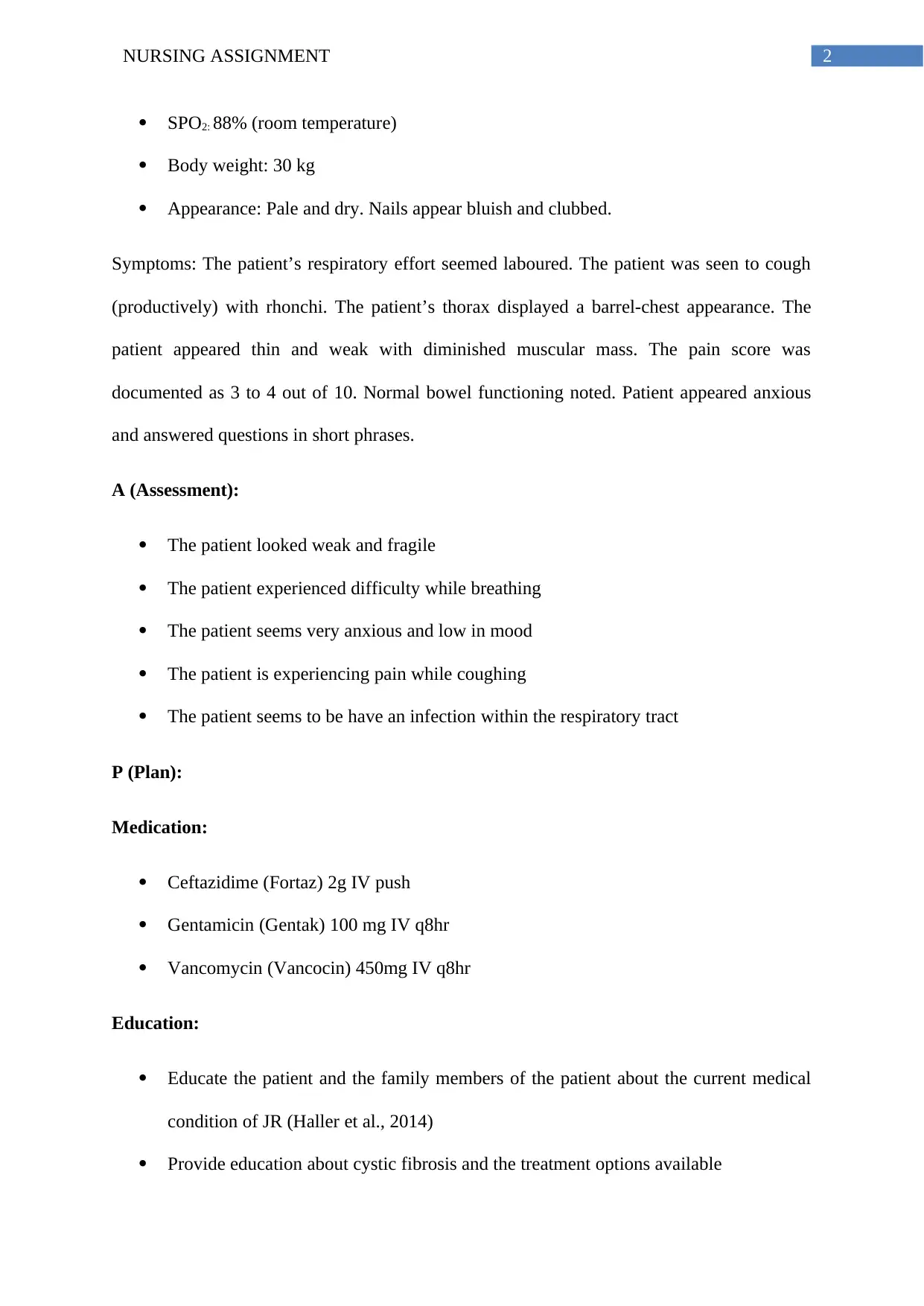
2NURSING ASSIGNMENT
SPO2: 88% (room temperature)
Body weight: 30 kg
Appearance: Pale and dry. Nails appear bluish and clubbed.
Symptoms: The patient’s respiratory effort seemed laboured. The patient was seen to cough
(productively) with rhonchi. The patient’s thorax displayed a barrel-chest appearance. The
patient appeared thin and weak with diminished muscular mass. The pain score was
documented as 3 to 4 out of 10. Normal bowel functioning noted. Patient appeared anxious
and answered questions in short phrases.
A (Assessment):
The patient looked weak and fragile
The patient experienced difficulty while breathing
The patient seems very anxious and low in mood
The patient is experiencing pain while coughing
The patient seems to be have an infection within the respiratory tract
P (Plan):
Medication:
Ceftazidime (Fortaz) 2g IV push
Gentamicin (Gentak) 100 mg IV q8hr
Vancomycin (Vancocin) 450mg IV q8hr
Education:
Educate the patient and the family members of the patient about the current medical
condition of JR (Haller et al., 2014)
Provide education about cystic fibrosis and the treatment options available
SPO2: 88% (room temperature)
Body weight: 30 kg
Appearance: Pale and dry. Nails appear bluish and clubbed.
Symptoms: The patient’s respiratory effort seemed laboured. The patient was seen to cough
(productively) with rhonchi. The patient’s thorax displayed a barrel-chest appearance. The
patient appeared thin and weak with diminished muscular mass. The pain score was
documented as 3 to 4 out of 10. Normal bowel functioning noted. Patient appeared anxious
and answered questions in short phrases.
A (Assessment):
The patient looked weak and fragile
The patient experienced difficulty while breathing
The patient seems very anxious and low in mood
The patient is experiencing pain while coughing
The patient seems to be have an infection within the respiratory tract
P (Plan):
Medication:
Ceftazidime (Fortaz) 2g IV push
Gentamicin (Gentak) 100 mg IV q8hr
Vancomycin (Vancocin) 450mg IV q8hr
Education:
Educate the patient and the family members of the patient about the current medical
condition of JR (Haller et al., 2014)
Provide education about cystic fibrosis and the treatment options available
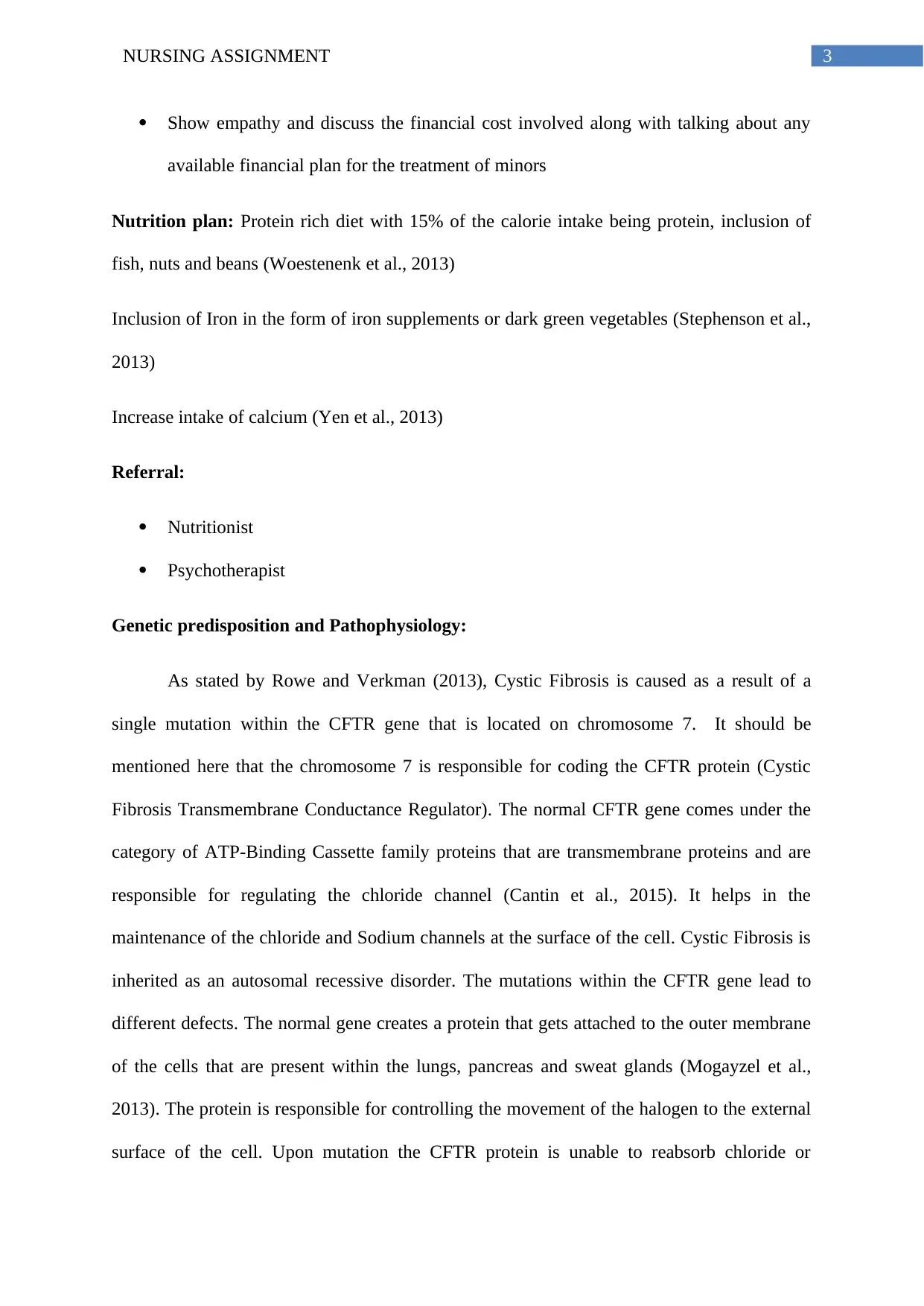
3NURSING ASSIGNMENT
Show empathy and discuss the financial cost involved along with talking about any
available financial plan for the treatment of minors
Nutrition plan: Protein rich diet with 15% of the calorie intake being protein, inclusion of
fish, nuts and beans (Woestenenk et al., 2013)
Inclusion of Iron in the form of iron supplements or dark green vegetables (Stephenson et al.,
2013)
Increase intake of calcium (Yen et al., 2013)
Referral:
Nutritionist
Psychotherapist
Genetic predisposition and Pathophysiology:
As stated by Rowe and Verkman (2013), Cystic Fibrosis is caused as a result of a
single mutation within the CFTR gene that is located on chromosome 7. It should be
mentioned here that the chromosome 7 is responsible for coding the CFTR protein (Cystic
Fibrosis Transmembrane Conductance Regulator). The normal CFTR gene comes under the
category of ATP-Binding Cassette family proteins that are transmembrane proteins and are
responsible for regulating the chloride channel (Cantin et al., 2015). It helps in the
maintenance of the chloride and Sodium channels at the surface of the cell. Cystic Fibrosis is
inherited as an autosomal recessive disorder. The mutations within the CFTR gene lead to
different defects. The normal gene creates a protein that gets attached to the outer membrane
of the cells that are present within the lungs, pancreas and sweat glands (Mogayzel et al.,
2013). The protein is responsible for controlling the movement of the halogen to the external
surface of the cell. Upon mutation the CFTR protein is unable to reabsorb chloride or
Show empathy and discuss the financial cost involved along with talking about any
available financial plan for the treatment of minors
Nutrition plan: Protein rich diet with 15% of the calorie intake being protein, inclusion of
fish, nuts and beans (Woestenenk et al., 2013)
Inclusion of Iron in the form of iron supplements or dark green vegetables (Stephenson et al.,
2013)
Increase intake of calcium (Yen et al., 2013)
Referral:
Nutritionist
Psychotherapist
Genetic predisposition and Pathophysiology:
As stated by Rowe and Verkman (2013), Cystic Fibrosis is caused as a result of a
single mutation within the CFTR gene that is located on chromosome 7. It should be
mentioned here that the chromosome 7 is responsible for coding the CFTR protein (Cystic
Fibrosis Transmembrane Conductance Regulator). The normal CFTR gene comes under the
category of ATP-Binding Cassette family proteins that are transmembrane proteins and are
responsible for regulating the chloride channel (Cantin et al., 2015). It helps in the
maintenance of the chloride and Sodium channels at the surface of the cell. Cystic Fibrosis is
inherited as an autosomal recessive disorder. The mutations within the CFTR gene lead to
different defects. The normal gene creates a protein that gets attached to the outer membrane
of the cells that are present within the lungs, pancreas and sweat glands (Mogayzel et al.,
2013). The protein is responsible for controlling the movement of the halogen to the external
surface of the cell. Upon mutation the CFTR protein is unable to reabsorb chloride or
Secure Best Marks with AI Grader
Need help grading? Try our AI Grader for instant feedback on your assignments.
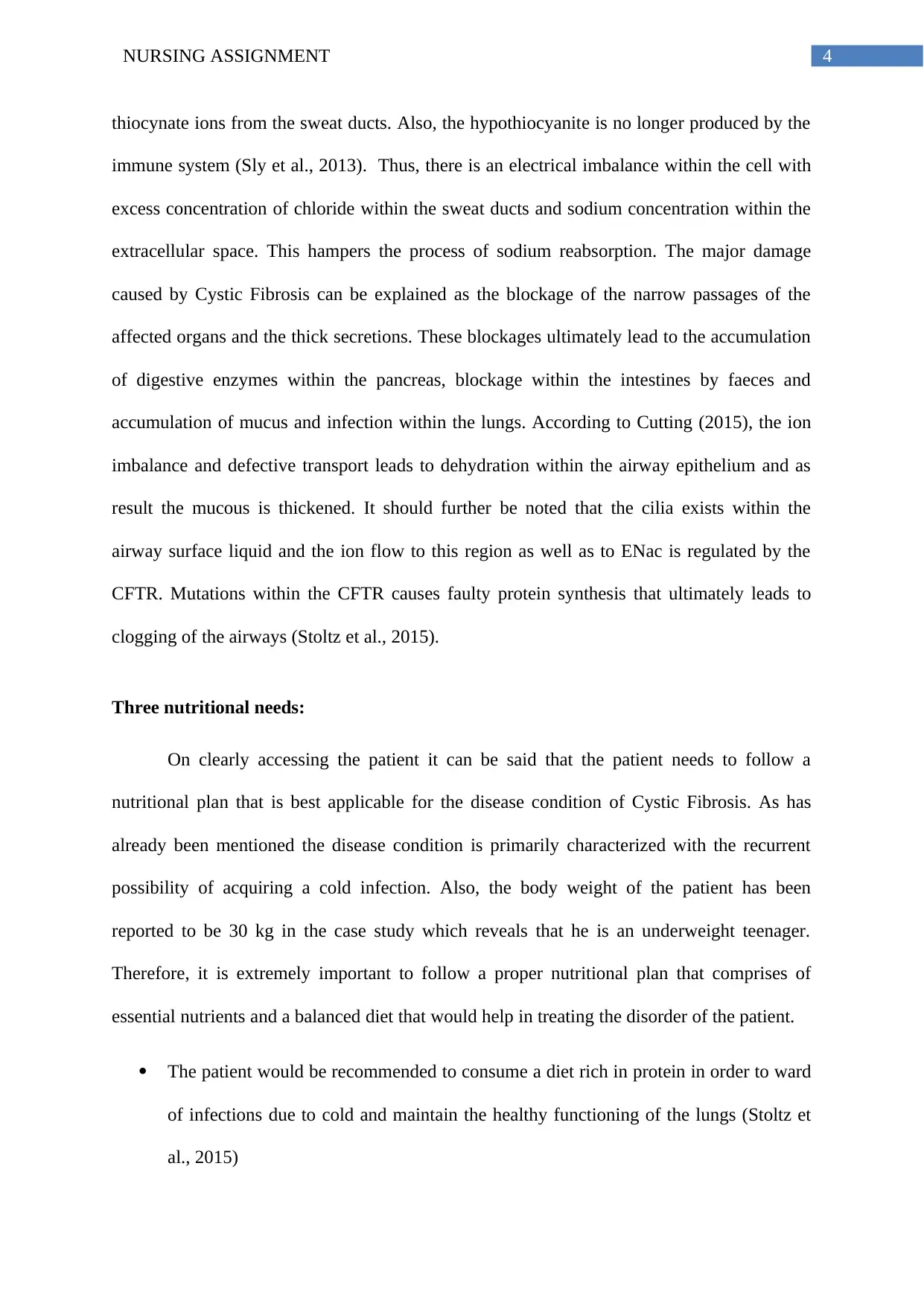
4NURSING ASSIGNMENT
thiocynate ions from the sweat ducts. Also, the hypothiocyanite is no longer produced by the
immune system (Sly et al., 2013). Thus, there is an electrical imbalance within the cell with
excess concentration of chloride within the sweat ducts and sodium concentration within the
extracellular space. This hampers the process of sodium reabsorption. The major damage
caused by Cystic Fibrosis can be explained as the blockage of the narrow passages of the
affected organs and the thick secretions. These blockages ultimately lead to the accumulation
of digestive enzymes within the pancreas, blockage within the intestines by faeces and
accumulation of mucus and infection within the lungs. According to Cutting (2015), the ion
imbalance and defective transport leads to dehydration within the airway epithelium and as
result the mucous is thickened. It should further be noted that the cilia exists within the
airway surface liquid and the ion flow to this region as well as to ENac is regulated by the
CFTR. Mutations within the CFTR causes faulty protein synthesis that ultimately leads to
clogging of the airways (Stoltz et al., 2015).
Three nutritional needs:
On clearly accessing the patient it can be said that the patient needs to follow a
nutritional plan that is best applicable for the disease condition of Cystic Fibrosis. As has
already been mentioned the disease condition is primarily characterized with the recurrent
possibility of acquiring a cold infection. Also, the body weight of the patient has been
reported to be 30 kg in the case study which reveals that he is an underweight teenager.
Therefore, it is extremely important to follow a proper nutritional plan that comprises of
essential nutrients and a balanced diet that would help in treating the disorder of the patient.
The patient would be recommended to consume a diet rich in protein in order to ward
of infections due to cold and maintain the healthy functioning of the lungs (Stoltz et
al., 2015)
thiocynate ions from the sweat ducts. Also, the hypothiocyanite is no longer produced by the
immune system (Sly et al., 2013). Thus, there is an electrical imbalance within the cell with
excess concentration of chloride within the sweat ducts and sodium concentration within the
extracellular space. This hampers the process of sodium reabsorption. The major damage
caused by Cystic Fibrosis can be explained as the blockage of the narrow passages of the
affected organs and the thick secretions. These blockages ultimately lead to the accumulation
of digestive enzymes within the pancreas, blockage within the intestines by faeces and
accumulation of mucus and infection within the lungs. According to Cutting (2015), the ion
imbalance and defective transport leads to dehydration within the airway epithelium and as
result the mucous is thickened. It should further be noted that the cilia exists within the
airway surface liquid and the ion flow to this region as well as to ENac is regulated by the
CFTR. Mutations within the CFTR causes faulty protein synthesis that ultimately leads to
clogging of the airways (Stoltz et al., 2015).
Three nutritional needs:
On clearly accessing the patient it can be said that the patient needs to follow a
nutritional plan that is best applicable for the disease condition of Cystic Fibrosis. As has
already been mentioned the disease condition is primarily characterized with the recurrent
possibility of acquiring a cold infection. Also, the body weight of the patient has been
reported to be 30 kg in the case study which reveals that he is an underweight teenager.
Therefore, it is extremely important to follow a proper nutritional plan that comprises of
essential nutrients and a balanced diet that would help in treating the disorder of the patient.
The patient would be recommended to consume a diet rich in protein in order to ward
of infections due to cold and maintain the healthy functioning of the lungs (Stoltz et
al., 2015)
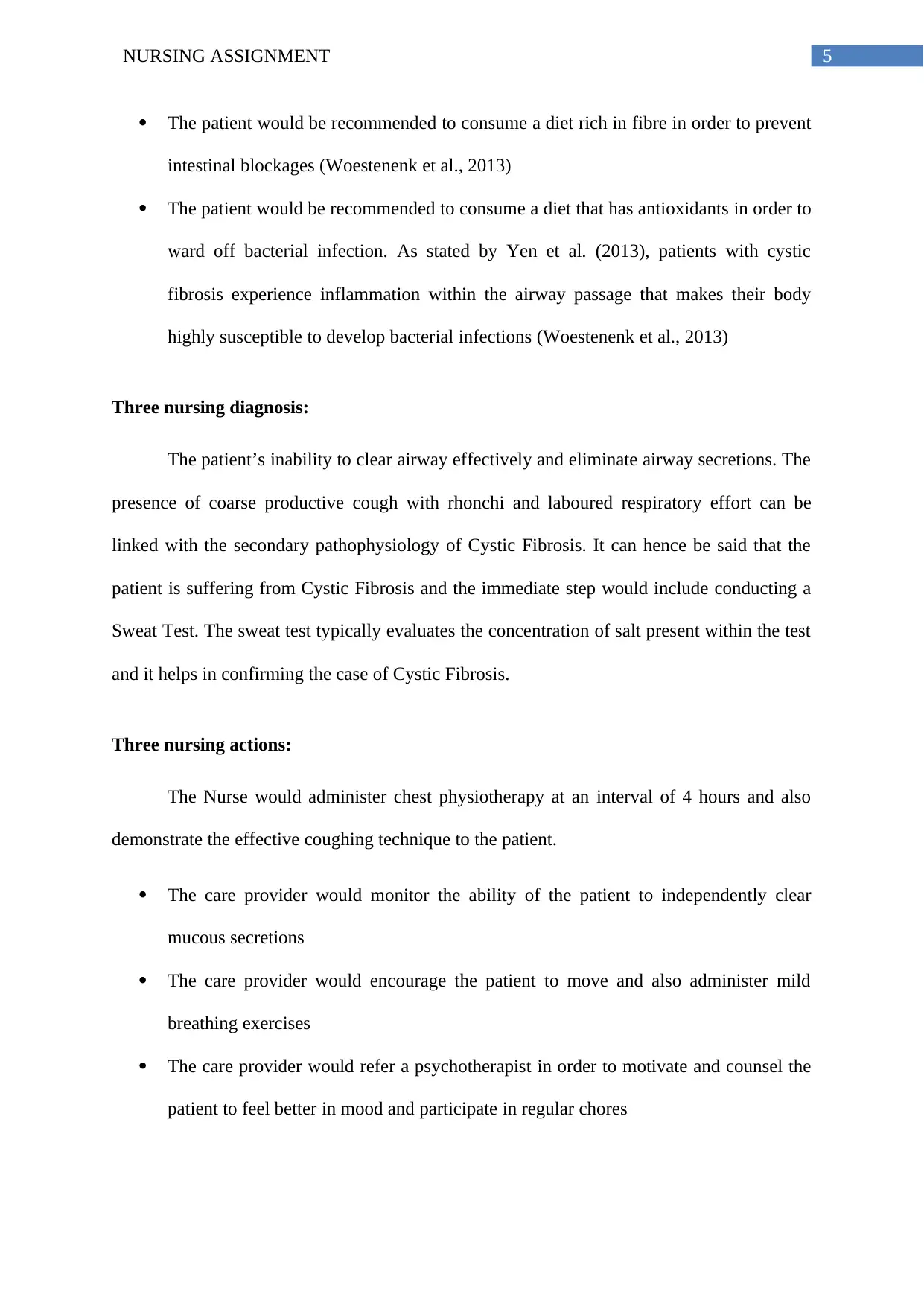
5NURSING ASSIGNMENT
The patient would be recommended to consume a diet rich in fibre in order to prevent
intestinal blockages (Woestenenk et al., 2013)
The patient would be recommended to consume a diet that has antioxidants in order to
ward off bacterial infection. As stated by Yen et al. (2013), patients with cystic
fibrosis experience inflammation within the airway passage that makes their body
highly susceptible to develop bacterial infections (Woestenenk et al., 2013)
Three nursing diagnosis:
The patient’s inability to clear airway effectively and eliminate airway secretions. The
presence of coarse productive cough with rhonchi and laboured respiratory effort can be
linked with the secondary pathophysiology of Cystic Fibrosis. It can hence be said that the
patient is suffering from Cystic Fibrosis and the immediate step would include conducting a
Sweat Test. The sweat test typically evaluates the concentration of salt present within the test
and it helps in confirming the case of Cystic Fibrosis.
Three nursing actions:
The Nurse would administer chest physiotherapy at an interval of 4 hours and also
demonstrate the effective coughing technique to the patient.
The care provider would monitor the ability of the patient to independently clear
mucous secretions
The care provider would encourage the patient to move and also administer mild
breathing exercises
The care provider would refer a psychotherapist in order to motivate and counsel the
patient to feel better in mood and participate in regular chores
The patient would be recommended to consume a diet rich in fibre in order to prevent
intestinal blockages (Woestenenk et al., 2013)
The patient would be recommended to consume a diet that has antioxidants in order to
ward off bacterial infection. As stated by Yen et al. (2013), patients with cystic
fibrosis experience inflammation within the airway passage that makes their body
highly susceptible to develop bacterial infections (Woestenenk et al., 2013)
Three nursing diagnosis:
The patient’s inability to clear airway effectively and eliminate airway secretions. The
presence of coarse productive cough with rhonchi and laboured respiratory effort can be
linked with the secondary pathophysiology of Cystic Fibrosis. It can hence be said that the
patient is suffering from Cystic Fibrosis and the immediate step would include conducting a
Sweat Test. The sweat test typically evaluates the concentration of salt present within the test
and it helps in confirming the case of Cystic Fibrosis.
Three nursing actions:
The Nurse would administer chest physiotherapy at an interval of 4 hours and also
demonstrate the effective coughing technique to the patient.
The care provider would monitor the ability of the patient to independently clear
mucous secretions
The care provider would encourage the patient to move and also administer mild
breathing exercises
The care provider would refer a psychotherapist in order to motivate and counsel the
patient to feel better in mood and participate in regular chores
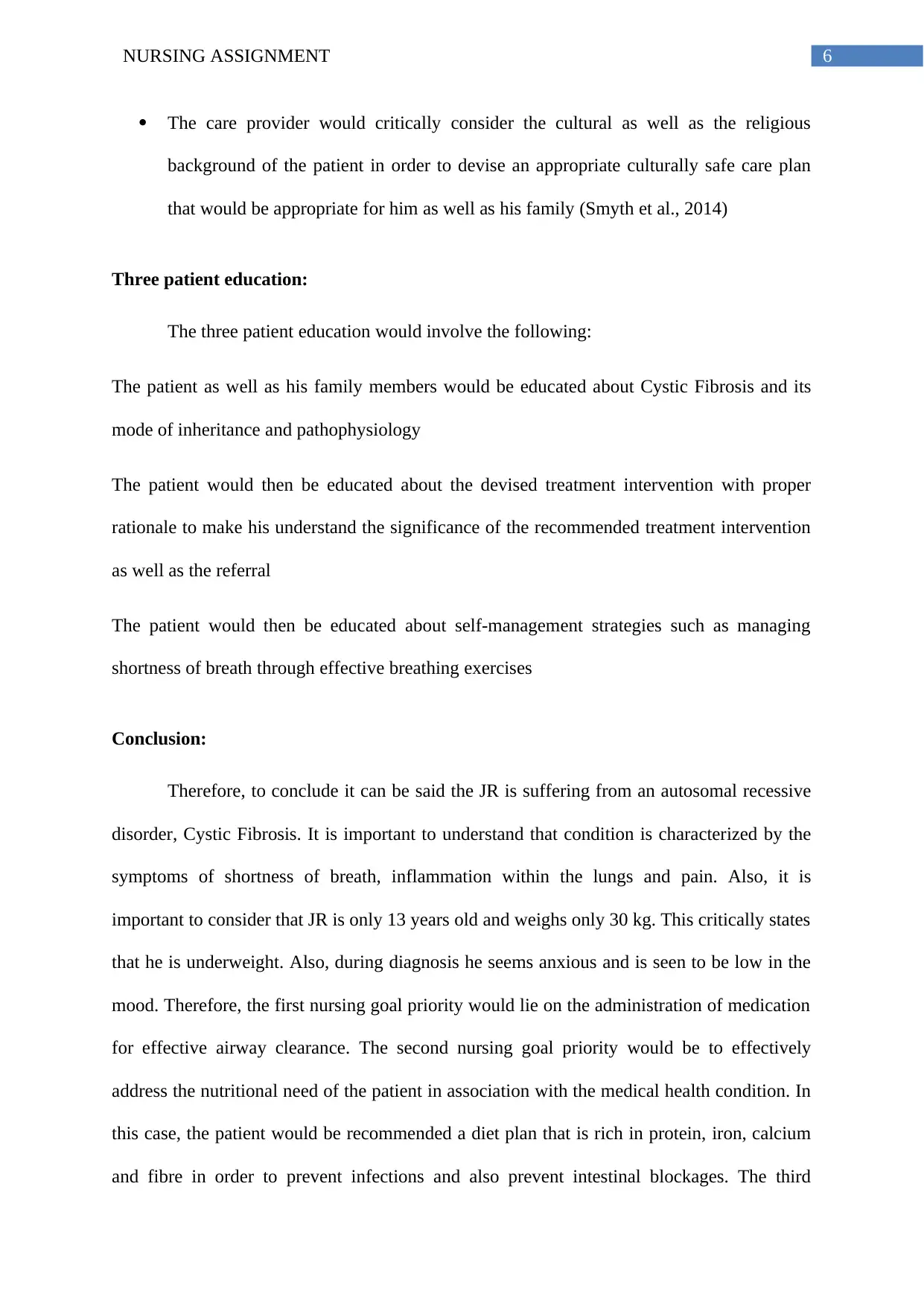
6NURSING ASSIGNMENT
The care provider would critically consider the cultural as well as the religious
background of the patient in order to devise an appropriate culturally safe care plan
that would be appropriate for him as well as his family (Smyth et al., 2014)
Three patient education:
The three patient education would involve the following:
The patient as well as his family members would be educated about Cystic Fibrosis and its
mode of inheritance and pathophysiology
The patient would then be educated about the devised treatment intervention with proper
rationale to make his understand the significance of the recommended treatment intervention
as well as the referral
The patient would then be educated about self-management strategies such as managing
shortness of breath through effective breathing exercises
Conclusion:
Therefore, to conclude it can be said the JR is suffering from an autosomal recessive
disorder, Cystic Fibrosis. It is important to understand that condition is characterized by the
symptoms of shortness of breath, inflammation within the lungs and pain. Also, it is
important to consider that JR is only 13 years old and weighs only 30 kg. This critically states
that he is underweight. Also, during diagnosis he seems anxious and is seen to be low in the
mood. Therefore, the first nursing goal priority would lie on the administration of medication
for effective airway clearance. The second nursing goal priority would be to effectively
address the nutritional need of the patient in association with the medical health condition. In
this case, the patient would be recommended a diet plan that is rich in protein, iron, calcium
and fibre in order to prevent infections and also prevent intestinal blockages. The third
The care provider would critically consider the cultural as well as the religious
background of the patient in order to devise an appropriate culturally safe care plan
that would be appropriate for him as well as his family (Smyth et al., 2014)
Three patient education:
The three patient education would involve the following:
The patient as well as his family members would be educated about Cystic Fibrosis and its
mode of inheritance and pathophysiology
The patient would then be educated about the devised treatment intervention with proper
rationale to make his understand the significance of the recommended treatment intervention
as well as the referral
The patient would then be educated about self-management strategies such as managing
shortness of breath through effective breathing exercises
Conclusion:
Therefore, to conclude it can be said the JR is suffering from an autosomal recessive
disorder, Cystic Fibrosis. It is important to understand that condition is characterized by the
symptoms of shortness of breath, inflammation within the lungs and pain. Also, it is
important to consider that JR is only 13 years old and weighs only 30 kg. This critically states
that he is underweight. Also, during diagnosis he seems anxious and is seen to be low in the
mood. Therefore, the first nursing goal priority would lie on the administration of medication
for effective airway clearance. The second nursing goal priority would be to effectively
address the nutritional need of the patient in association with the medical health condition. In
this case, the patient would be recommended a diet plan that is rich in protein, iron, calcium
and fibre in order to prevent infections and also prevent intestinal blockages. The third
Paraphrase This Document
Need a fresh take? Get an instant paraphrase of this document with our AI Paraphraser
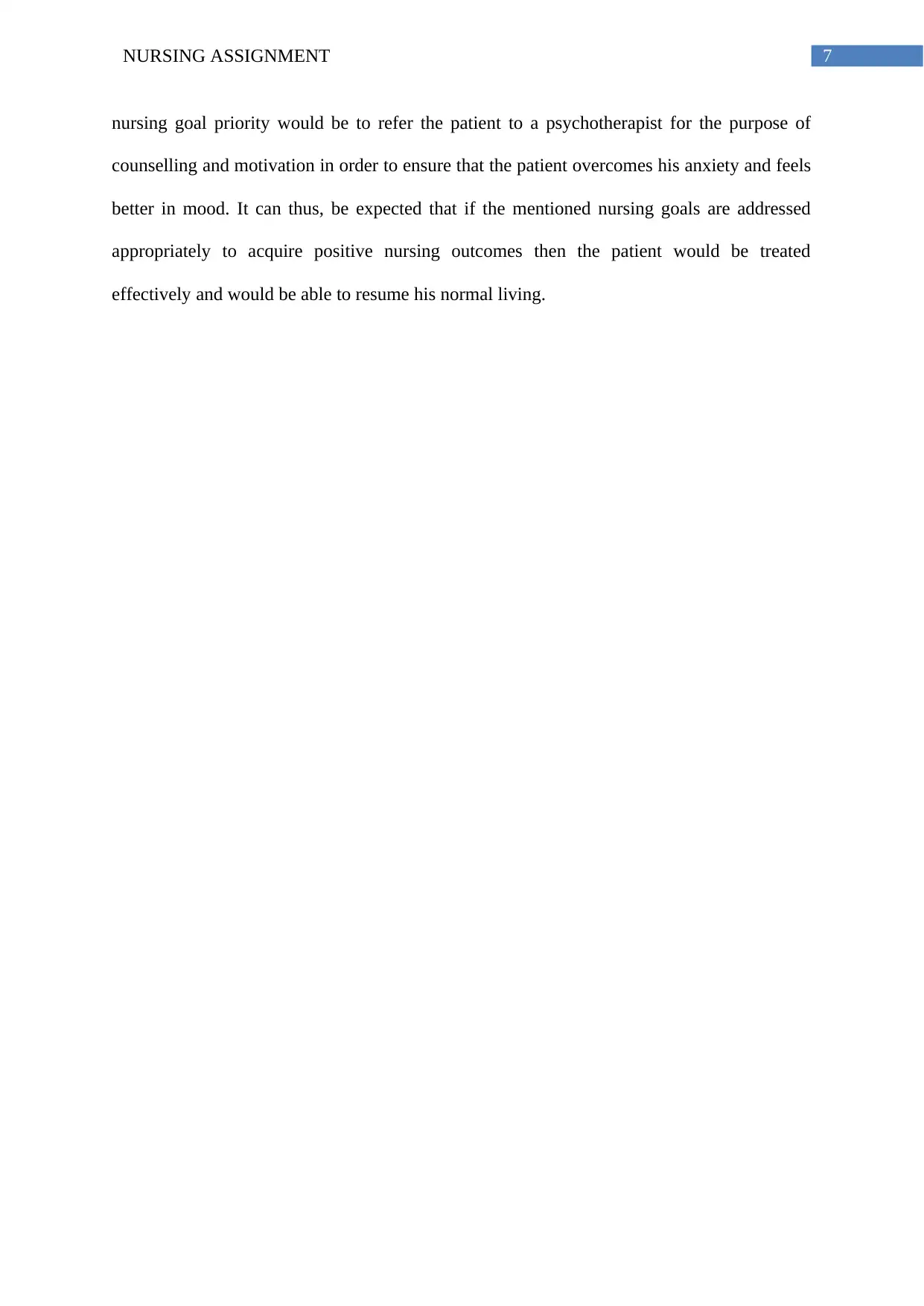
7NURSING ASSIGNMENT
nursing goal priority would be to refer the patient to a psychotherapist for the purpose of
counselling and motivation in order to ensure that the patient overcomes his anxiety and feels
better in mood. It can thus, be expected that if the mentioned nursing goals are addressed
appropriately to acquire positive nursing outcomes then the patient would be treated
effectively and would be able to resume his normal living.
nursing goal priority would be to refer the patient to a psychotherapist for the purpose of
counselling and motivation in order to ensure that the patient overcomes his anxiety and feels
better in mood. It can thus, be expected that if the mentioned nursing goals are addressed
appropriately to acquire positive nursing outcomes then the patient would be treated
effectively and would be able to resume his normal living.
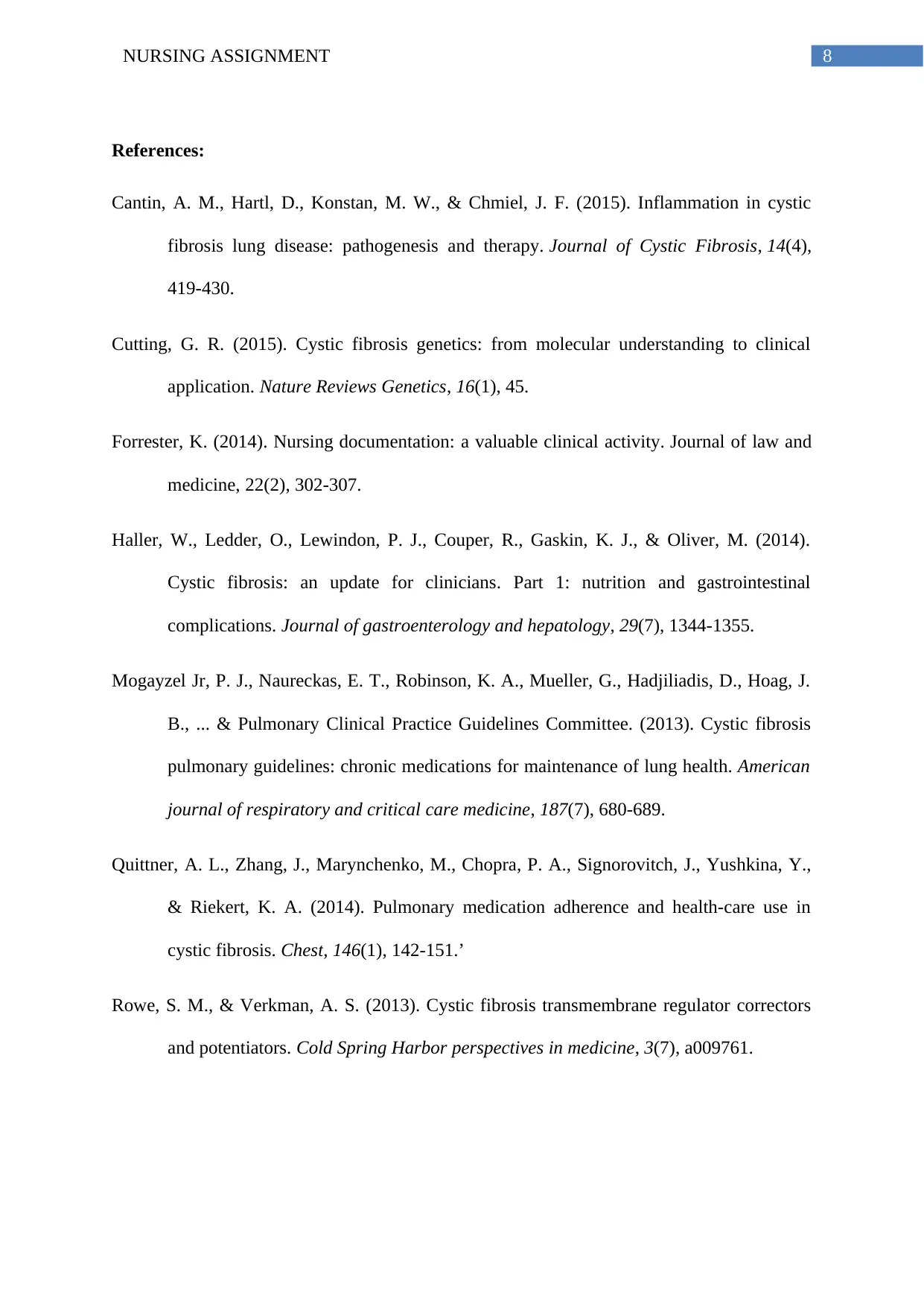
8NURSING ASSIGNMENT
References:
Cantin, A. M., Hartl, D., Konstan, M. W., & Chmiel, J. F. (2015). Inflammation in cystic
fibrosis lung disease: pathogenesis and therapy. Journal of Cystic Fibrosis, 14(4),
419-430.
Cutting, G. R. (2015). Cystic fibrosis genetics: from molecular understanding to clinical
application. Nature Reviews Genetics, 16(1), 45.
Forrester, K. (2014). Nursing documentation: a valuable clinical activity. Journal of law and
medicine, 22(2), 302-307.
Haller, W., Ledder, O., Lewindon, P. J., Couper, R., Gaskin, K. J., & Oliver, M. (2014).
Cystic fibrosis: an update for clinicians. Part 1: nutrition and gastrointestinal
complications. Journal of gastroenterology and hepatology, 29(7), 1344-1355.
Mogayzel Jr, P. J., Naureckas, E. T., Robinson, K. A., Mueller, G., Hadjiliadis, D., Hoag, J.
B., ... & Pulmonary Clinical Practice Guidelines Committee. (2013). Cystic fibrosis
pulmonary guidelines: chronic medications for maintenance of lung health. American
journal of respiratory and critical care medicine, 187(7), 680-689.
Quittner, A. L., Zhang, J., Marynchenko, M., Chopra, P. A., Signorovitch, J., Yushkina, Y.,
& Riekert, K. A. (2014). Pulmonary medication adherence and health-care use in
cystic fibrosis. Chest, 146(1), 142-151.’
Rowe, S. M., & Verkman, A. S. (2013). Cystic fibrosis transmembrane regulator correctors
and potentiators. Cold Spring Harbor perspectives in medicine, 3(7), a009761.
References:
Cantin, A. M., Hartl, D., Konstan, M. W., & Chmiel, J. F. (2015). Inflammation in cystic
fibrosis lung disease: pathogenesis and therapy. Journal of Cystic Fibrosis, 14(4),
419-430.
Cutting, G. R. (2015). Cystic fibrosis genetics: from molecular understanding to clinical
application. Nature Reviews Genetics, 16(1), 45.
Forrester, K. (2014). Nursing documentation: a valuable clinical activity. Journal of law and
medicine, 22(2), 302-307.
Haller, W., Ledder, O., Lewindon, P. J., Couper, R., Gaskin, K. J., & Oliver, M. (2014).
Cystic fibrosis: an update for clinicians. Part 1: nutrition and gastrointestinal
complications. Journal of gastroenterology and hepatology, 29(7), 1344-1355.
Mogayzel Jr, P. J., Naureckas, E. T., Robinson, K. A., Mueller, G., Hadjiliadis, D., Hoag, J.
B., ... & Pulmonary Clinical Practice Guidelines Committee. (2013). Cystic fibrosis
pulmonary guidelines: chronic medications for maintenance of lung health. American
journal of respiratory and critical care medicine, 187(7), 680-689.
Quittner, A. L., Zhang, J., Marynchenko, M., Chopra, P. A., Signorovitch, J., Yushkina, Y.,
& Riekert, K. A. (2014). Pulmonary medication adherence and health-care use in
cystic fibrosis. Chest, 146(1), 142-151.’
Rowe, S. M., & Verkman, A. S. (2013). Cystic fibrosis transmembrane regulator correctors
and potentiators. Cold Spring Harbor perspectives in medicine, 3(7), a009761.
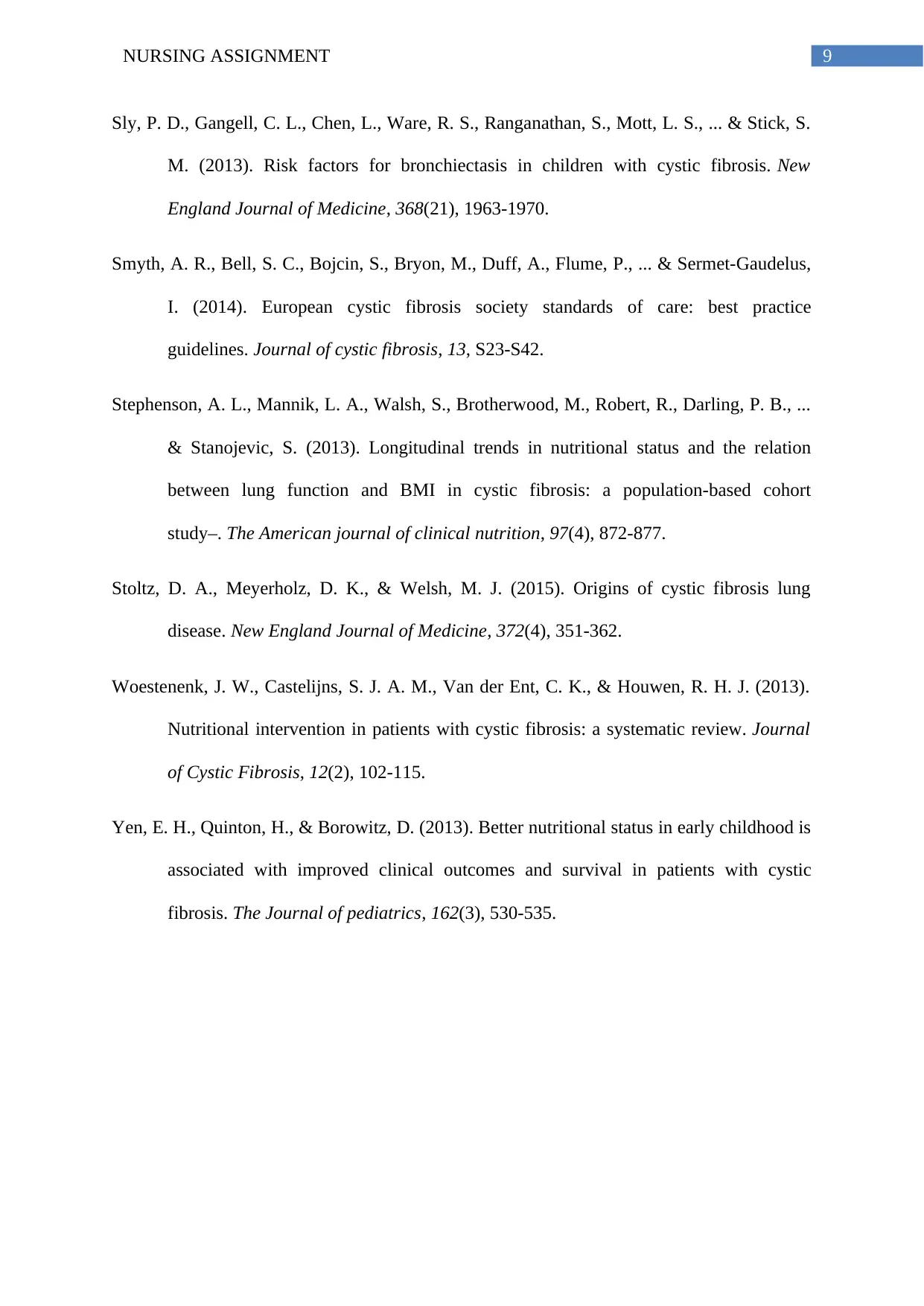
9NURSING ASSIGNMENT
Sly, P. D., Gangell, C. L., Chen, L., Ware, R. S., Ranganathan, S., Mott, L. S., ... & Stick, S.
M. (2013). Risk factors for bronchiectasis in children with cystic fibrosis. New
England Journal of Medicine, 368(21), 1963-1970.
Smyth, A. R., Bell, S. C., Bojcin, S., Bryon, M., Duff, A., Flume, P., ... & Sermet-Gaudelus,
I. (2014). European cystic fibrosis society standards of care: best practice
guidelines. Journal of cystic fibrosis, 13, S23-S42.
Stephenson, A. L., Mannik, L. A., Walsh, S., Brotherwood, M., Robert, R., Darling, P. B., ...
& Stanojevic, S. (2013). Longitudinal trends in nutritional status and the relation
between lung function and BMI in cystic fibrosis: a population-based cohort
study–. The American journal of clinical nutrition, 97(4), 872-877.
Stoltz, D. A., Meyerholz, D. K., & Welsh, M. J. (2015). Origins of cystic fibrosis lung
disease. New England Journal of Medicine, 372(4), 351-362.
Woestenenk, J. W., Castelijns, S. J. A. M., Van der Ent, C. K., & Houwen, R. H. J. (2013).
Nutritional intervention in patients with cystic fibrosis: a systematic review. Journal
of Cystic Fibrosis, 12(2), 102-115.
Yen, E. H., Quinton, H., & Borowitz, D. (2013). Better nutritional status in early childhood is
associated with improved clinical outcomes and survival in patients with cystic
fibrosis. The Journal of pediatrics, 162(3), 530-535.
Sly, P. D., Gangell, C. L., Chen, L., Ware, R. S., Ranganathan, S., Mott, L. S., ... & Stick, S.
M. (2013). Risk factors for bronchiectasis in children with cystic fibrosis. New
England Journal of Medicine, 368(21), 1963-1970.
Smyth, A. R., Bell, S. C., Bojcin, S., Bryon, M., Duff, A., Flume, P., ... & Sermet-Gaudelus,
I. (2014). European cystic fibrosis society standards of care: best practice
guidelines. Journal of cystic fibrosis, 13, S23-S42.
Stephenson, A. L., Mannik, L. A., Walsh, S., Brotherwood, M., Robert, R., Darling, P. B., ...
& Stanojevic, S. (2013). Longitudinal trends in nutritional status and the relation
between lung function and BMI in cystic fibrosis: a population-based cohort
study–. The American journal of clinical nutrition, 97(4), 872-877.
Stoltz, D. A., Meyerholz, D. K., & Welsh, M. J. (2015). Origins of cystic fibrosis lung
disease. New England Journal of Medicine, 372(4), 351-362.
Woestenenk, J. W., Castelijns, S. J. A. M., Van der Ent, C. K., & Houwen, R. H. J. (2013).
Nutritional intervention in patients with cystic fibrosis: a systematic review. Journal
of Cystic Fibrosis, 12(2), 102-115.
Yen, E. H., Quinton, H., & Borowitz, D. (2013). Better nutritional status in early childhood is
associated with improved clinical outcomes and survival in patients with cystic
fibrosis. The Journal of pediatrics, 162(3), 530-535.
1 out of 10
Related Documents
Your All-in-One AI-Powered Toolkit for Academic Success.
+13062052269
info@desklib.com
Available 24*7 on WhatsApp / Email
![[object Object]](/_next/static/media/star-bottom.7253800d.svg)
Unlock your academic potential
© 2024 | Zucol Services PVT LTD | All rights reserved.




